Top News
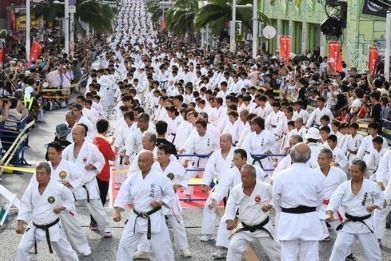
January 17, 2017 Ryukyu Shimpo
The 1st Okinawa International Karate Tournament will be held in August of 2018 to both solidify Okinawa’s status as the birthplace of Karate, and also to give practitioners and enthusiasts a place to interact. Related to the commemoration of the opening of the Okinawa Karate Kaikan on March 4, the festival is set to take place at the new Kaikan as well as the Okinawa Prefectural Budokan.
Okinawa had previously hosted 4 international Karate and Kobudo tournaments, however these were one-time events. Since this new tournament aims to be a recurring event, it is being dubbed the first. The competition will consist only of “Kata,” and aims to have participants from over 40 countries.
On January 16 at a hotel in Naha, a general assembly was held where an executive committee for the tournament was established. Governor Takeshi Onaga was appointed chairman, and 45 committee members were selected from Karate and Kobudo preservation societies from Okinawa and other prefectures, the Okinawa Traditional Karate Promotion Association, and economic organizations.
At the general assembly an outline for the tournament was announced. The tournament is scheduled to take place from August 1-8 (including extra days). Also, as part of the effort to preserve and pass down traditional Okinawan Karate, it was decided that “Kata” will be written with the traditional character, “型” as opposed to the more modern “形”. Okinawa had previously hosted an international tournament in 2009 that had 600-700 participants from 40 countries, and it is anticipated that this new tournament will be even larger.
Governor Onaga emphasized at the assembly, “I think the international tournament will not only promote Okinawan Karate, but will also become something of great importance. I hope that the tournament will give us a chance to strengthen Okinawa’s role as the birthplace of Karate, as well as assemble Karate lovers from all over the world, allowing us to spread Okinawan Karate worldwide.” He also asked the committee members for their support and cooperation.
As for the importance of the opening of the Okinawa Karate Kaikan, and as part of its promotion, Governor Onaga stated, “We will continue to take many steps to share Okiawan Karate throughout Japan and the World,” stressing the Karate Hall be actively made use of.
The assembly has three goals for the tournament. The first is to create a place for Karate lovers to gather and interact. The second is the preservation and passing down of the technique and spirituality of Okinawan Karate by the pioneers who have systematically kept it alive. The third goal is the promotion of Okinawan Karate and Kobudo looking towards the future.
The second general assembly will be held in April. The second assembly will establish five special committees for judging, demonstrations, general affairs and ceremonies, seminars, and completion. The committees will then set to the task of figuring out the details of the tournament in preparation for the real thing.
There are a big expectations from the Karate community for the opening of the 1st International Tournament. Choko Kiyuna, chairman of the Okinawa Traditional Karate Promotion Association said, “Organizations started with the purpose of preserving and passing down traditional Kata have been increasing. So, I want us to do our best to make sure this tournament is a success.”
(English translation by T&CT and Sam Grieb)
Go to Japanese
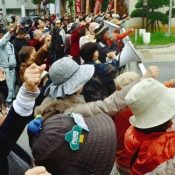
January 17, 2017 Ryukyu Shimpo
On January 16, a prefectural citizens’ organization opposing the relocation of U.S. bases within Okinawa held an emergency protest action in front of the Naha District Court to demand the immediate release of Okinawa Peace Movement Center Director Hiroji Yamashiro, who was arrested and indicted over his protest activities opposing the construction of a new base in Henoko, Nago City and has been in detention for approximately three months. According to organizer estimates, 400 people joined the protest, and participants called out for their friend to be returned to them. A petition calling for Yamashiro’s immediate release had gathered more than 29,000 signatures as of that morning, and former House of Councilors member Tokushin Yamauchi and others plan to submit the petition to the Naha District Court on January 17.
The Naha District Court responded to the protest by closing its gates and dispatching employees to the scene. From outside the gate, protesters called out, “Don’t allow unjust detention!” They also called out words of encouragement to Yamashiro, who is being detained in the Naha Branch Detention House behind the Naha District Court, saying, “Keep up your spirits! We are all with you!”
“There is no conceivable reason for detaining [Yamashiro] except as an attempt to suppress Okinawa’s voice and stop our action. We can’t allow this unjust detention that disregards human rights,” said Suzuyo Takazato, a co-representative of the prefectural citizen’s organization opposing the relocation of U.S. bases within Okinawa.
(English translation by T&CT and Sandi Aritza)
Go to Japanese

January 12, 2017 Ryukyu Shimpo
By Wu Li Jun
The ownership and management rights of the Sheraton Okinawa Sunmarina Resort, which had renewed itself last year as a global hotel brand, were resold to the domestic real estate development giant, Mori Trust. Ever since Okinawa tourism recovered back in 2013, the foreign-affiliated hotel operator Ishin Hotels Group began to sell off its hotels in Okinawa one after another. This is a hotel revival technique in which they raise the real estate value by renewing old properties and selling them for more than the original price the hotel was acquired at. The resell value, which has not been made public, is close to 21 billion yen, according to Japanese trade magazines that have been reporting on this topic with interest.
Even before the global financial crisis in 2008, which inflicted a crushing blow to the domestic economy, Ishin had been acquiring multiple hotels in Okinawa.
During its golden age, Ishin had possessed land for facilities and buildings, such as: the Okinawa Port Hotel, long-established Grand Ocean in Naha, Renaissance Resort Okinawa, and Coco Garden Resort Okinawa. However, Ishin no longer possesses these properties.
The Sheraton Okinawa Sunmarina Resort is also a long-established hotel, which is 30 years-old having opened its doors in 1987. Ishin had bought it and began managing it in 2006. Starting in late 2015, Ishin put down about 4 billion and began expanding the hotel. The hotel, which was run-down, was drastically improved, and was rebranded as a Sheraton Hotel beginning last June.
The Nikkei Real Estate Market Report published that Ishin had originally acquired the Sunmarina Resort at about eight billion yen, and sold it for more than 20 billion yen to Mori Trust. Regarding Mori Trust entering the Okinawa hotel market, the same magazine analyzed the situation as the Mori Trust Reit Investment Corporation aiming to take on lodging demands that are to swell from a series of efforts. They also plan to go public.
When Ryukyu Shimpo asked about the resale price and plans for development in Okinawa, a Ishin Group representative said, “The person in charge is currently unavailable” and have yet to give us an answer.
Ishin Group is not the only company that is buying and selling hotel ownership and/or management rights. In the past several years, this type of business has become popular. Even the “separation of ownership and management of hotels,” which was common overseas, has become increasingly popular in the last several years.
■ Separation of Ownership and Management
The real estate fund associated company, operated by investment company Morgan Stanley, bought the ownership of the Rihga Royal Gran Okinawa, a hotel in Asahimachi of Naha, from Kanehide Holdings Co., Ltd. The resale price of this was also not made public. However, according to a representative from Kanehide, “(Morgan Stanley) presented a number that was far more than what was expected,” and they decided to sell the hotel.
Professor Keiryu Uechi is a visiting professor at the University of Ryukyus Department of Tourism Science and Industrial Management and has experience in working at hotels. According to him, “Foreign-affiliated corporations generally manage hotels between three to eight years. They must renew the brand and/or renovate the hotel to increase the value to be able to resell it.” He also added, “Since foreign tourists have increased in recent years, it is a good time to resale and/or acquire (hotels). The fact that the buying and selling (of hotels) is happening is good news to Okinawa.”
(English translation by T&CT and Chelsea Ashimine)
Go to Japanese

January 12, 2016 Ryukyu Shimpo
(Tokyo) On January 2, Tokyo MX, a local Tokyo television station, aired an episode of its program “News Girls” in which it attacked protesters opposed to the construction of helipads in the northern part of Okinawa Island, calling them terrorists. On the morning of January 12, Tokyo residents and others held a protest demonstration in front of the Tokyo MX building in Chiyoda Ward, Tokyo. Mari Kawana, a freelance magazine editor, used SNS to call on people to join the protest, and seventeen people joined, saying that the program constituted hate speech and that the broadcaster should apologize, correct the mistake and air a program investigating the actual facts.
Kawana addressed the crowd with a microphone, saying, “It’s unbelievable to say that the sit-in protesters [in Okinawa] are getting paid to be there. It is a huge problem that public air waves were used to broadcast these lies.” She added, “[the program] ridiculed a struggle for human dignity. It is hate speech. It is we, in mainland Japan, who force Okinawa to host the bases. I want [the broadcaster] to realize that.”
(English translation by T&CT and Sandi Aritza)
Go to Japanese

January 8, 2017 Ryukyu Shimpo
Fourth-generation Okinawan Shirley Higa from Hawaii recently met with her relative Shigeo Asato who lives in Kishaba, Kitanakagusuku Village. Shirley’s only clue in her search for family was the passport of her first-generation great-grandfather, Masae Higa. She joyfully admitted: “I didn’t think I would find them.”
Shirley and her father, Derrick, attended the Worldwide Kitanakagusuku Reception Ceremony on October 28 last year. These relatives were able to find each other due to Shirley and Derrick telling other attendees that they were searching for family from Kitanakagusuku Village, and a photograph taken in Hawaii by Masakame (Shigeo’s father and Masae’s older brother). Shigeo had been showing the photograph around and asking if anyone knows the boy shown. The picture is of Derrick when he was a child.
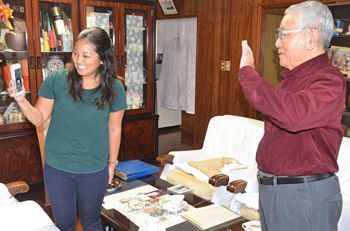
Shigeo waves to his relatives in Hawaii through Shirley’s smartphone.
Shigeo did not think he had relatives in Hawaii, but he remembered a story his older brother told him about their older brother. The story was that he had been sent to Hawaii as a war criminal after his time in the Japanese Army’s Blood and Iron Student Corps. Masae had gone to Hawaii to see him.
About ten years have passed since Derrick started doing genealogical research into his family in 2007 and requested assistance from University of Hawaii. He plans to visit Okinawa two years from now. Derrick said, “When I heard that we found [our relatives] I was extremely happy.” He enthusiastically declared, “If we meet up I want to go shopping with them.” Shigeo is impatiently waiting to welcome Derrick and show him around Kishaba Ward.
Shirley lives in Okinawa with her husband, who works at Kadena Air Base. She commented: “At home I would make sata andagi with my grandmother, and go to sanshin lessons with my father. Okinawan blood runs through my veins.”
Shigeo waved awkwardly over a video call to Derrick in Hawaii. This is just one example of family ties that bind Hawaii and Okinawa.
(English translation by T&CT and Erin Jones)
Go to Japanese

January 10, 2016 Ryukyu Shimpo
By Masatoshi Inafuku
Model Yoko Matsushima, who is originally from Shuri, Naha City, Okinawa and is now a model based in Tokyo and appears in fashion magazines, TV commercials, and cosmetics company catalogues, also produces tofuyo in Okinawa. Matsushima’s tofuyo is characterized by being made using a secret production method passed down since the era of the Ryukyu Kingdom. It is made in large pieces and filled with concentrated umami, and has a smooth, mellow flavor. Because it is entirely handmade, it takes a great deal of work to make, but Matsushima is active both as a model and a producer of tofuyo as she travels between Tokyo and Okinawa.
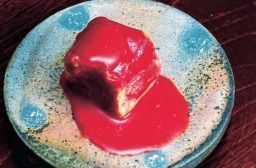
Tofuyo made by Yoko Matsushima
The tofuyo that Matsushima makes uses only products produced in Okinawa, including shimadofu (Okinawan tofu), koji (malt), and aged awamori (Okinawan liquor). She dries shimadofu in the Okinawan sun and ferments it in “nanban” jars made by her father, who is a potter. Matsushima stresses the importance of making her tofuyo locally, saying, “Once I tried drying [the tofu] in the sun in Tokyo, but it got much too dry. I think Okinawa’s humid climate is ideal for making tofuyo.”
Because her maternal grandmother, who inherited the production method passed down for generations, used to make tofuyo at home, Matsushima was familiar with the taste from a young age. “When our extended family gathered together, my grandmother would bring out specially made tofuyo from a back room. We would all eat tofuyo while enjoying our time together. I have so many wonderful memories,” says Matsushima, expressing her steadfast love for tofuyo.
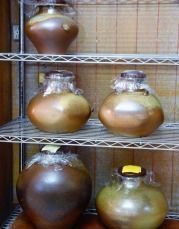
Nanban jars for fermenting tofuyo made by Matsushima’s father, a potter
Matsushima’s grandmother never sold her tofuyo, but her aunt, who inherited the production method, began selling it under the brand name “Old-fashioned Tofuyo Yogi”. Matsushima started learning how to make tofuyo from her aunt eighteen years ago, and in November 2015 she became independent and started the brand “Tofuyo Matsushima”.
Matsushima returns to Okinawa once every three months to work on making tofuyo. It is crucial to dry the tofu correctly, and she says she needs to tend to it carefully for three or four days while constantly checking the weather, humidity and wind.
Because her aunt sells her products in Okinawa, Matsushima decided to sell hers in Tokyo and online, and she went door-to-door to izakayas in Tokyo to try to find customers for her products. They can now be found in four shops in Azabujuban, Shimbashi, Ginza and Jimbocho. Matsushima does everything from production to sales, marketing and shipping herself.
In contrast to modelling, where she expresses herself within the framework of a plan that has been given to her, when making tofuyo, Matsushima starts from scratch and spends time on every step. “As a model, my job is to be used and consumed, but when making tofuyo, I need to take action to make anything happen. Now that I do both, I feel like my mental balance has improved,” says Matsushima, expressing a sense of fulfillment in having two such different professions.
(English translation by T&CT and Sandi Aritza)
Go to Japanese

January 8, 2017 Ryukyu Shimpo
The consulting company Blueship Okinawa (Naha, CEO Hiroumi Keimatsu) and with three Okinawan liquor makers held a press conference at the Chuko Distillery on January 7, announcing the development of a branding project with the goal of expanding “Ryukyu Awamori” into overseas markets. In order to explore the possibility of Awamori as a hard liquor akin to whiskey or other spirits, they are developing a three year plan for selling the liquor overseas as a base for cocktails as a way to enter the vintage market.
This will be a joint operation between Chuko Distillery, Zuisen Distillery, and Kumejima’s Kumeisen. The planning will be handled by Blueship, and will make use of the Okinawa General Buruea’s Okinawa International Hubcluster. In order to improve Awamori’s recognition as a hard liquor, the companies are working on developing new cocktails with Awamori as its base. They are developing a test product for sale in certain American and Western European markets that could be ready as early as next summer, and will be conduction marketing research at foreign bars and restaurants.
At the press conference, Blueship CEO Hiroumi Keimatsu said of the undertaking, “We are conducting product development and branding for Awamori with the help of experts, in hopes that it will lead to sales in the United States and Europe.” Chuko Distillery CEO Tsutomu Oshiro added, “A large part of the international market is dominated by hard liquor. We want to pursue the potential of Awamori, which has history throughout the world.”
In order to construct a sales strategy and product development for the overseas market, the group has invited five marketing experts from the United States and Europe to tour the distillery and for consultation from January 4-10. Natalie Sokoloff, the marketing team’s project manager, said regarding the appeal of Awamori, “I look forward to tasting the differences between new batches and vintages. While it bears similarity to the clear and colorless vodka, Awamori has a smooth taste that cannot be compared. You get the impression that it’s the ‘real deal.’”
(English translation by T&CT and Sam Grieb)
Go to Japanese
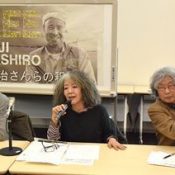
January 13, 2017 Ryukyu Shimpo
On January 12 in Tokyo, documentary writer Satoshi Kamata, author Keiko Ochiai, and commentator Makoto Sataka held a press conference calling for the release of Chairman Hiroji Yamashiro of the Okinawa Peace Movement Center, who was arrested more than 80 days ago and continues to be detained by police. Yamashiro is involved in the opposition movements to construction of a new base in Henoko and construction of helipads in Takae.
Kamata says: “A leader is being confined long-term to block the [opposition] movement. This is absolutely unacceptable.”
The three holding the press conference announced that since mid-December signatures of 16,528 people from 66 counties calling for Yamashiro’s release have been collected. These signatures will be submitted to Naha District Court this month. As signatures are being collected online, among other efforts, the word of these movements is spreading.
(English translation by T&CT and Erin Jones)
Go to Japanese
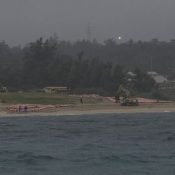
January 6, 2017 Ryukyu Shimpo
The Okinawa Defense Bureau placed floats around U.S. Camp Schwab on January 6 to advance construction of the new Henoko base, which is part of the relocation of the U.S. Marine Corps Futenma Air Station. The operation was carried out using heavy machinery on the beach to move the floats towards the ocean. There was heavy rainfall at the site.
Two inflatable boats from the Japan Coast Guard have been sent out, but the other 15 boats remained at the floating dock on January 5. No working ships can be seen. People opposing the construction went out on protest boats, however they returned to the port due to heavy rain as of 9:30 a.m. They discussed further activities.
At the same time, approximately 50 protestors were sitting in front of the Camp Schwab gate from 7:00 a.m. in the pouring rain.
There are no reports of any large deployment of riot police officers or installation of construction materials. The participants chanted that they won’t allow the construction and “rain won’t stop them”.
(English translation by T&CT and Sayaka Sakuma)
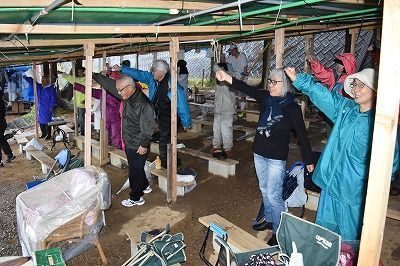
Citizens shout in protest against the new base construction.
Go to Japanese
January 1, 2017 Ryukyu Shimpo
From October to November 2016, the Ryukyu Shimpo implemented an opinion survey in order to learn about changes in the views of Okinawans. Similar surveys were conducted in 2001, 2006, and 2011, making this the fourth survey of its kind. Compared to 2006, people who responded to the question “What do you think Okinawa’s position within Japan should be going forward?” with the answer “Okinawa should remain a part (prefecture) of Japan” decreased 15.7 percentage points, falling to 46.1%, or less than half. Meanwhile, respondents who said that Okinawa should have greater authority in the domestic and diplomatic arenas, including supporters of independence, rose to 34.5%. It is thought that one reason people who believe Okinawa should have increased authority regarding local autonomy rose to more than one third of respondents, approaching in number those who support the status quo, is that people are unhappy that the national government does not take Okinawan views into consideration when it comes to issues regarding U.S. bases.
People who responded that they could both understand and speak Shimakutuba, the traditional Okinawan languages, fell 3.5 percentage points to 41.2%, and was only 7.5% among respondents in their twenties.
As with the previous survey, more respondents viewed the Battle of Okinawa as an important event in Okinawa’s modern and contemporary history than any other event, but the percentage of such responses fell to 45.7%, dropping to less than half for the first time.
Regarding the ideal state of Okinawa’s local autonomy, aside from “it should remain the same”, answers included “Okinawa should adopt a framework where it has increased authority to compile Okinawa-related budgets and other domestic authorities (e.g. becoming an independent state, locally autonomous state, or special prefecture within Japan)” (17.9%), “Okinawa should adopt a federal framework where it has increased domestic authority and also authority equal to that of the national government in terms of diplomacy and security” (14.0%) and “Okinawa should become independent” (2.6%).
In terms of political issues people are concerned with, 53.8% of respondents said “low incomes” and 46.2% said “base issues”. This was the second time base issues ranked second, a trend continuing from the 2011 survey. Respondents who said that U.S. bases should be removed or reduced were 60.5%. Meanwhile, people who accepted Japan Self-Defense Force bases exceeded half for the first time, with 52.8% saying that they should either be kept at the current scale or expanded.
86.3% of respondents said that they “very much” or “somewhat” feel pride in being Okinawan, and 95.6% said that they feel pride in Okinawa’s culture and arts, similar to previous surveys. Although 70.9% of respondents said they are satisfied with their lives, 38.6% said that their current greatest concern is “income”.
Survey methodology
For the survey, Okinawa’s 41 cities, towns and villages were divided into five districts, and area random sampling was performed to pick 55 locations corresponding to population ratio. Surveyors visited households in each location between October 15 and November 25 of last year, and a total of 1047 individuals 20 years and older responded to questions.
(English translation by T&CT and Sandi Aritza)
Go to Japanese
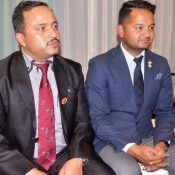
January 6, 2017 Ryukyu Shimpo
Allegations that Nepalese international students attending Japanese language schools and a vocational school in Okinawa are being sexually harassed has been spread by Social Networking Sites (SNS) since the end of the last year, causing concern in Nepal. Some parents in Nepal are worried and are encouraging students to return home. The Nepalese government-authorized private organization “Non-Resident Nepali Association (NRNA)” Japan Chapter’s Vice President Tanka Prasad Gaire and General Secretary Anuj Thapa visited Okinawa on the 5th and started investigating the situation, visiting three Japanese language schools.
According to the Japan Chapter, last December an online news article from “NepalJapan.com” used by Nepalese in Japan reported a student testimony. One of three nationwide newspapers in Nepal also reported it.
It is the first time the Chapter has investigated claims of students being sexually harassed in Japan. The survey investigated rumors among international students that female students are being targeted, but the victims have not been identified. They conducted interviews with international students on the 6th.
According to Nepal’s report, the school held on to residence cards which students are required to carry with them. Schools and international students responded to the survey, stating that this was the case in the past, but not now.
The survey also looked at the issue of foreign students exceeding the part-time job limit of 28 hours a week, stressing that the law must be observed, but pointing out that the high cost of school tuitions and dormitory expenses leads to students seeking to work extra hours.
They went to on to say that neither the schools nor the immigration bureau have tried to solve the problem as far as they know.
Thapa also questioned the method of recruiting students to the Japanese language schools. He said, “Schools cannot run without students. Schools just collect the number of students they want and leave the responsibility (of living in Japan) to students. It has become a business.”
NRNA has 68 chapters all over the world. In Japan, there are 12 branches including the Okinawa branch.
(English translation by T&CT and Megumi Chibana)
Go to Japanese














 Webcam(Kokusai Street)
Webcam(Kokusai Street)


